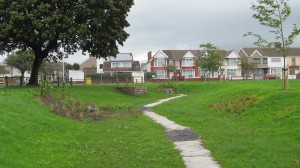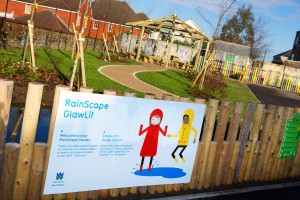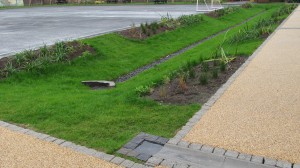RainScape – The Welsh approach to SuDS in an urban environment
Jeremy Jones, Dŵr Cymru Welsh Water
At Dŵr Cymru Welsh Water, we are proud to provide over three million people with a reliable source of high quality tap water, whilst protecting public health and the environment in our care by removing sewage safely and responsibly. We are also proud that we are different to other companies. Whatever gains we make, we return to our customers either in further improvements to the service they receive or lower bills.
We are also proud that we are the first water company to be rolling out an innovative sustainable drainage system programme that we have named “RainScape”. RainScape manages excess surface water entering the sewer network – yes, a large scale retrofit project which is being taken forward by a water company.
“How are you doing this?” I hear you ask.
Welsh Water has had a surface water management strategy in place since 2005 and has worked to develop evidence and gain support for a more sustainable way of managing surface water since this time. This work has been so successful that using sustainable solutions as a way of dealing with the root cause of a number of issues has now been embedded as part of business as usual. Around £80m has been allocated to using the “RainScape” approach from 2015 to 2020.
“RainScape” has been developed using a range of recognised techniques such as SuDS and WSUD and are complimented with more traditional elements where needed, to make the interventions function correctly. The key to the success of RainScape is partnership working. Without developing the key relationships needed with local authorities, Natural Resources Wales and other local partners we would be unable to take this work forward. This is a new way of working for a water company and has meant that new processes and ways of working have been developed.
And the best news about this approach is we’ve put it into practice, and have real examples of functioning SuDS interventions in the urban environment in Wales. That’s right, no more pictures of Malmo and Portland. We have real life, Welsh examples!
We have committed to undertaking work to manage surface water in the Llanelli and Gowerton areas of West Wales to reduce spill frequency to the Loughor Estuary. We had options of how we dealt with the number of spills into the Estuary. We could use our RainScape solutions across the catchment, such as swales, basins, planters and permeable paving, to deal with the issues at root cause and provide societal and amenity benefits to the community. Or, we could have built a storm tank that would be as large the nearby rugby stadium. Of course, we went for the more sustainable option, which also costs considerably less. It not only helps to solve the problem of spills into the Estuary, but also addresses localised sewer flooding issues and will be more resilient to climate change than a traditional tank solution. These schemes will give the community amenities they can be proud of.
In 2013 we have completed two schemes in Llanelli and have started construction of others. Another 10 schemes will be completed by the end of 2015, with around another 60 to be delivered between 2015 and 2020.
Queen Mary’s Walk, Llanelli was the first scheme to be completed in the summer of 2013. It involved the retrofit of a 130m planted swale, into which surface water flows were diverted from residential streets and lanes. Kerbside bioretention basins have also been constructed. The primary purpose of the swale is to attenuate storm flows and it is estimated that peak pipe flows have been reduced from 125l/s to 29l/s. Since construction, the swale has operated a number of times and has drained down within a few hours.
The second scheme in Llanelli was at Stebonheath Primary School, a few streets away from Queen Mary’s Walk. Modelling indicated that peak storm flows entering the combined system from the school area were around 61l/s. It is estimated that the completed scheme will reduce peak flows to around 3l/s.
A number of interventions have been used at the school, including a 30m swale, geocellular units, raingarden planters and a bioretention basin. As well as these storm water attenuation solutions, we have installed a range of other features to improve the landscape and sustainability of the school. These include water butts, permeable paving and, following consultation with the school children, a woodland walk, a bug hotel and an outdoor classroom.
The construction work took place over the summer holidays and due to last summer’s great Welsh weather, was completed ahead of programme. Since completion, the school has had visits from lots of people and organisations, including other water companies and other schools in the area.
The work we are doing is part of a long term strategy and isn’t just a series of pilot projects. We intend to do this work where the benefits to Welsh Water, our customers and the local environment far outweigh those of traditional pipe and tank solutions. We will be working with a range of organisations in the near future including Cardiff Council and will look at creating a number of community focused green streets which feature ‘pocket parks’ in Cardiff. This will drastically reduce the surface water runoff whilst enhancing the local aesthetic and property values. The removal of this water will reduce our pumping and energy cost overheads as well as creating headroom for tens of thousands of new properties and commercial premises to support the growth of the Welsh capital.


